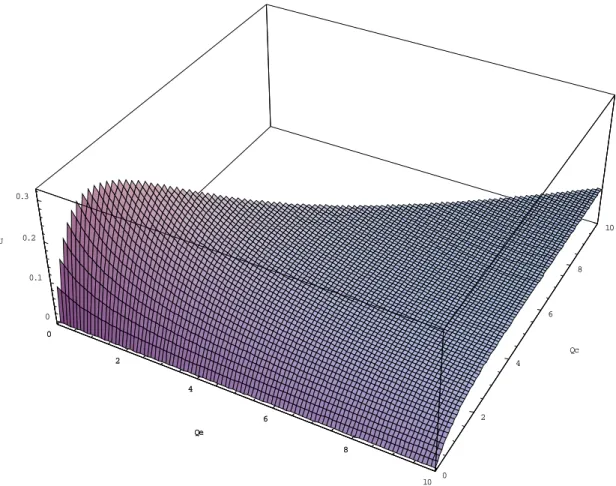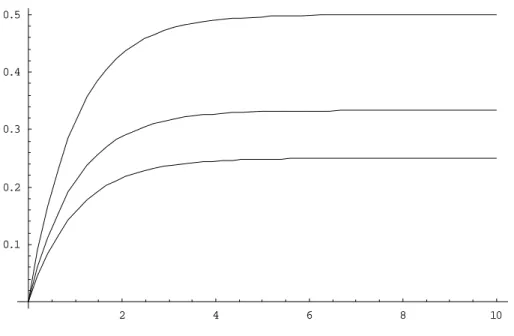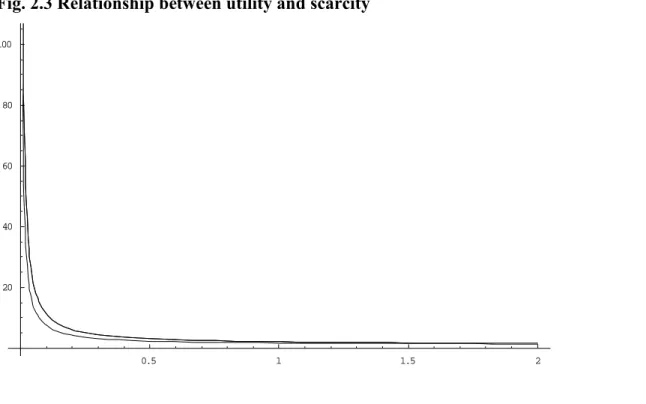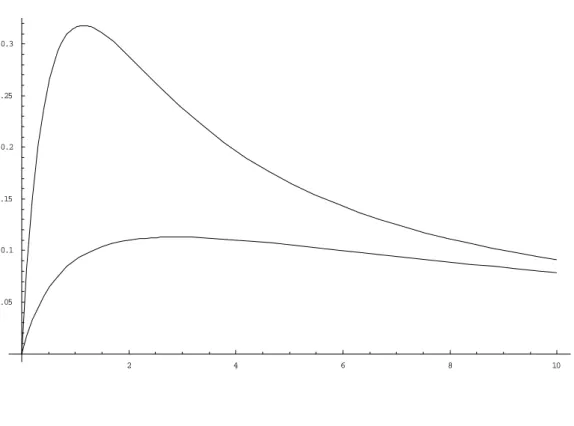The Scarcity Bias: Some Theoretical Notes
DRAFT VERSION
LUIGI MITTONE
Department of Economics, University of Trento, Via Inama 5, 38100, Trento, ITALY [email protected]
IVAN SORAPERRA
CEEL, University of Trento, Via Inama 5, 38100, Trento, ITALY
Abstract
The bias generated by the subjective perception of scarcity on the consumer’s choice is discussed from a theoretical perspective. The core idea here discussed is that scarcity is an Lancasterian attribute of the goods which is not endogenously built in the goods, like many physical attributes, color, weight, etc. but which is dependent from the context where the good is consumed. The exogenously nature of scarcity requires a specific theoretical treatment which is here attempted.
Keywords: Scarcity, Decision-making, Economic behavior, Economic theory
1. Introduction: back to Adam Smith
This paper takes the hint from two empirically based ones (Mittone, Savadori and Rumiati, 2005, Mittone, Savadori, 2006)1 and examines the attraction effect produced by scarcity on the consumer behavior theory. More precisely what is investigated here has nothing to do with the so called Veblen’s effect (Veblen, 1899/1965) and therefore we are not specifically interested to study the properties of the demand of some special categories of luxury goods (who someone calls ostentation goods).
What is here analyzed is a more general phenomenon which is related to the psychological role played by the perception that a normal good is a scarce one, given the place and time where and when is consumed. It is important to underline that what matters here is not the real availability of a good but the perception that the consumer has of the local amount of a given good at disposal for consumption. From now on the term “scarcity” has to be considered as a synonymous of “subjectively perceived scarcity” and that the perception of scarcity is linked to the belief that in a given moment in time and in a specific place a given good is scarce.
A better way to describe the specific definition of scarcity discussed here is to use the consumer theory developed by Kelvin Lancaster (1966a, 1966b). As well known the theory by Lancaster can be considered as part of a wider theoretical frame the so called New Household Theory (NHT thereafter) which represents an attempt (around the sixties and seventies) to overcome one of the weakest point of the neoclassical theory of consumption, that is to say the assumption of stable and given preferences. Even if the building of NHT is the result of the work of other Authors (in particular of Becker, 1965) the part of NHT which is relevant here is related to the special assumption made by Lancaster with respect to the nature of the goods.
Lancaster assumes that the purchased goods enter in the consumer’s utility function as sets of characteristics produced by the goods themselves. In other words the consumer is not interested to the goods but to the services that she can obtain from their use. In this sense the majority of the characteristics of goods can be considered as “intrinsic” or “stable”. From apparently different goods (e.g. a car and an airplane ticket) the consumers can extract the same service (in the example of the car and of the airplane ticket the service is transportation) together with other services which can be completely different. From the car the consumer can extract the pleasure of driving (if she likes to drive), while this is not possible with the airplane ticket, vice versa with the airplane ticket the consumer can obtain also the pleasure to fly (if she likes to fly).
Using the same definition of goods suggested by the Lancaster’s theory helps to clarify why scarcity is a so peculiar characteristic. Most of the attributes of a good in the Lancasterian approach are intrinsically built in the good itself. More precisely to be intrinsic means that a specific set of attributes is embodied in a given good independently from the context where the good is purchased and consumed. The attribute of scarcity, conversely, is not intrinsic but it is context-dependent. To know if a good owns the scarcity attribute, that is to say to know if it can be considered scarce or abundant, a consumer needs to know its “local” availability, whereas to know the presence-absence of a generic attribute (for instance the color) a consumer needs only information relative to the good itself and not to the environment. Moreover, to perceive the degree of scarcity the consumer often needs to know the level of competition on the demand side. To know the total availability of a good can be not enough because the consumer can perceive it as scarce – independently form the total amount of that good existing in nature – because she knows that many other consumers wish that good.
To look for some preceding reference to the role of scarcity in the explanation of the consumer behavior means to go back to Adam Smith and to his distinction between “value in use” and “value in exchange”. To explain the difference between these two concepts he
presented the famous paradox of diamonds and water. As well known the diamonds and water paradox tells that even if water is very useful it is also generally very cheap while diamonds have little if none utility but they are very expensive. From this paradox Smith arrived to conclude that the willingness to pay does not depend from the degree of usefulness of the goods, i.e. he argues that the value of goods is not influenced by their characteristics but by some other mechanism, in his words: “the merit of an object, which is in any degree either useful or beautiful, is greatly enhanced by its scarcity” (Smith 1776, p.172). It is worth noticing that the Smith’s sentence underlines a sort of ante littera behavioralism because it links in some way the preferences building process to the perception of a specific attribute – scarcity – .
In the Smith’s paradox we can find both the sources of scarcity: context dependent scarcity – linked to the Smith’s definition of value in use – and demand competition scarcity – which is related to the value in exchange –. Water can assume the scarcity attribute because in a given moment in time and in a given place in space (e.g. in a desert) it is a very limited resource. In spite of the fact that the absolute value in use has not changed water becomes very valuable in the desert independently from the consumer’s need. In fact at a given moment in time the consumer can be perfectly fine in the desert because she does not feel any need to drink. Still she will surely attribute a much higher value to a liter of water in the desert than to the same liter of water when staying on the border of an alpine lake.
On the other side the scarcity attribute for diamonds is almost totally due to the pressure exerted by the demand competition. Diamonds are not scarce in absolute terms (as a matter of fact they are relatively abundant in nature) but they are highly demanded and therefore they become scarce assuming an high value in exchange. The consumer can be totally uninterested to diamonds by themselves because she cannot extract any utility from them – she simply does not like diamonds – but still she will attribute a high value to a diamond. The value subjectively attributed by the consumer to a diamond would be high either because she is aware that it is a “rare” commodity – “the merit of an object,…., is greatly enhanced by its scarcity” – and because she knows that diamonds are an highly requested commodity and therefore she knows that she could extract value by exchanging it on the market.
About one century after the Wealth of Nations (1776) the Adam Smith’s paradox has been attacked by the Neoclassical economists. The concept of marginal utility allows in fact to re-link the value of goods to utility and to explain why a consumer will pay one carat of diamonds millions times the price of a gallon of water. As well known the idea embodied in the marginal concept utility is that the value attributed to a given commodity by a consumer is determined by
the ratio between the total utility that s/he obtains from the amount of the good already owned and the amount of utility that s/he can extract from an additional unit of the good itself. Through an apparently simple mechanism of comparison among the marginal utilities divided by the price of each good the consumer should then arrive to determine her/his willingness to pay for each amount of every existing good. The relative scarcity/abundance of a given good is in some way “embodied” in the objective characteristics of the goods itself through the market price and becomes a non relevant element for the consumer when she builds up her preference maps.
In spite of the fact that neoclassical economists are almost totally miser in explaining from where preferences come from it seems reasonable to think that the preferences building mechanism that they have in mind should be linked in some way to the strength of the needs or wishes that the consumer feels for each specific good. This means that the high value attributed to water in the desert should be due to a strong thirst or to the forecast of a future extreme need of water. Then the amount of water that the consumer will actually buy will depend by the price of water (in the desert), by her budget constraint and by all the other needs she must cope with (and by the prices of the other goods). In this sense to know if water is scarce or abundant is not relevant and in any case does not matter for building up the preferences map which broadly depends only from individual needs.
Similarly also the value attributed to diamonds by the consumer in the neoclassical view should be a consequence of the wish to own a beautiful thing (which is a cultural as well as a physical attribute of diamonds themselves) or to own something that can be re-sold in the future (un-material attribute). Once again the amount of diamonds purchased by the consumer is only a matter of budget constraint and prices.
A point of weakness of the Neoclassical solution of the Smith’s paradox relies on the implicit assumption that the preferences structure of the consumer cannot be influenced by the relative local disposable amount of each commodity. Telling it in a different manner this means that the level of utility that the consumer can obtain from a given good is independent from the amount of the good existing in nature. Vice versa when this is not the case the marginal utility loses its property of “stable” measure of the willingness to pay because utility becomes dependent from the amount of the commodity existing in nature. It emerges a system of double interaction between the preferences structure and the quantity of the good in nature. This double system can generate modifications in the standard properties of the utility surface.
Finally for a sake of completeness it is worth remembering that from a macro perspective in the neoclassical world scarcity simply does not matter (one could say does not exists) because
the market would provide to automatically re-adjust the local availability of any possible good through the general equilibrium. The physical re-distribution of goods is ensured by the price mechanism combined with the interconnections among local markets. From the neoclassical perspective scarcity of water in the desert is not a state of nature: it is only a consequence of the market. Las Vegas is in the middle of a desert but water is abundant as is in almost any other US towns.
The point here is not to argue on the neoclassical treatment of the attribute of scarcity while to discuss on the psychological effect produced on consumer behavior by the perception that a given good owns the attribute of scarcity. It is important to remember that we are here speaking of perceived scarcity and not of “real” scarcity. More precisely we are interested to the attractive mechanism put forth by the attribute of scarcity on consumer choice.
2. A parametric model of scarcity
In the introduction we anticipated that we shall restrict ourselves to treat only the case of subjectively perceived scarcity linked to a contextual effect. We move from two hypotheses: H1) the consumer feels a psychological attraction for all those goods which she perceives as
scarce in nature, this means that her utility level is influenced by the pleasure to consume a scarce good;
H2) the “state of nature” which determines the relative availability of a given good is strictly
local and temporarily limited to a given moment in time, e.g. time t0 (the state of the world here
and now).
A possible way to cope with the theoretical treatment of the consumer behavior when there is a good characterized by scarcity is to use a specification of the utility function able to take into account the relationship between utility and the perceived amount of the good existing in nature.
The utility function of equation 2.1 models a consumer whose utility depends directly on the quantity consumed Qcyof a scarce good y and inversely on the total amount of y existing in nature Qey. y e Q
Q
U
y c+
−
=
−1
æ
1
[2.1]The utility surface reported in fig. 2.1. has been obtained by computing equation 2.1 in the arbitrarily chosen parametric space for 0 ≤ Qcy ≤ 10 and 0 ≤ Qey ≤ 10.
Fig. 2.1 Utility surface
0 2 4 6 8 10 Qe 0 2 4 6 8 10 Qc 0 0.1 0.2 0.3 U 0 2 4 6 8 Qe
The utility surface of fig. 2.1 is referred to a good (y) which has two Lancasterian attributes: an endogenous one and a context dependent one. The endogenous attribute refers to “standard” characteristics of goods like colours, weight and so on. The context dependent attribute (scarcity) gives the consumer a level of utility which depends inversely on the amount of the good existing in nature. Due to the effect produced by the standard attribute, an increase in the amount of the quantity consumed (Qc axis) increases utility, following the standard law of
decreasing marginal utility. Instead, an increase in the quantity of the good existing in nature causes a variation in the marginal utility which depends on the specific parameterization chosen for the function 2.1. More precisely, the higher the psychological value given to scarcity and the lower the amount of the good in nature (Qe axis), the higher the level of utility obtained.
In fig. 2.2 the horizontal axis reports the amount of quantity consumed while the vertical axis measures the level of utility. To each level of the utility curves corresponds a different degree of scarcity which means that higher utility curves match up lower amounts of y available in nature. It is also worth noticing that the shape of the utility curves of fig. 2.2 is coherent with the decreasing marginal utility law, as already anticipated.
Fig. 2.2 Longitudinal section (Qc axis) of the utility surface
2 4 6 8 10 0.1 0.2 0.3 0.4 0.5
The graph shown in fig. 2.3 has been obtained by fixing a given amount of quantity consumed (the vertical axis measures the utility level while the horizontal axis reports the amount of a given good existing in nature). The graph shows the relationship between the utility level and the quantity of y existing in nature. The scarcity effect reduces the total utility gained by the consumption of y as the amount of y existing in nature increases
Fig. 2.3 Relationship between utility and scarcity 0.5 1 1.5 2 20 40 60 80 100
Finally the graph reported in fig. 2.4 shows the relationship between utility (always reported on the vertical axis, while the horizontal axis reports the total quantity of y existing in nature) and the amount of y consumed by the consumer accordingly with the overall quantity of y owned by the consumer herself. The two curves show respectively a situation where the consumer holds 100% of the good existing in nature – higher curve – and a situation where the consumer owns only the 20% of the total quantity of y. It is worth noticing that increasing the quantity of y consumed also the utility level increases but this positive relationship worth until y remains in the scarcity region (idem est until there are only few units of y available in nature). The curves of fig. 2.4 demonstrate the existence of a “destruction paradox”, which means that for the consumer could be rational to destroy the good that she holds because in this way she increases the fraction of total utility generated by scarcity more than the relative loss in utility caused by the reduction of the quantity consumed. When the consumer holds the total amount of the good the shape of the utility curve does not change but the relative steepness decreases and the destruction paradox loses its strength.
Fig. 2.4 The destruction paradox 2 4 6 8 10 0.05 0.1 0.15 0.2 0.25 0.3 3. Conclusions
The theoretical exercise here tried cannot be considered conclusive for two reasons: first because is based on a parametric approach and therefore cannot be generalised, second because the mathematical properties of the model have not been completely discussed.
More precisely the results that we have obtained are closely related to the hypotheses introduced in the model. The first hypothesis is that the first derivative, with respect to the quantity consumed, must be positive and the second derivative must be negative, – and accordingly with the standard theory – the second hypothesis is that the first derivative, with respect to the quantity available in nature, must be lower than zero and the second derivative must be greater than zero. Given these assumptions the level of utility which depends from scarcity – i.e. which depends from the amount of the good existing in nature – decreases with a relative lower degree as the amount of the good existing in nature increases.
Unfortunately we have not verified the partial derivatives and therefore we cannot generalize the results obtained with particular concern with the paradox of destruction. Nevertheless the model shows the existence of at least one example of the paradox, conditioned to the specific parameters chosen in the model.



